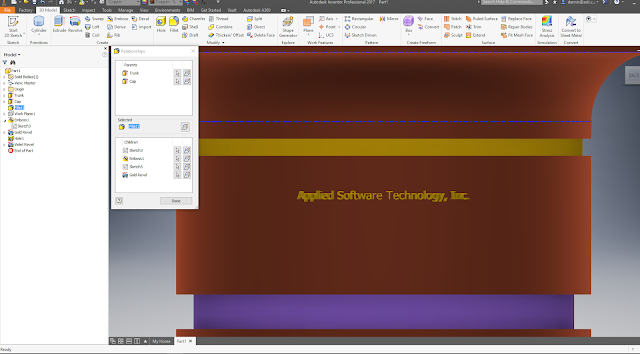Inventor
2017 New Features
First
in a series of “My Favorite New Features”
Under
the category of Part Creation, a new
Feature Relationship tool is available by right-clicking on the part in the
Model Tree and then selecting Relationships.
A
bit of orientation on the model shown.
Focus should be primarily on the features Fillet1,
Emboss 1 and the Gold Revel. Also note, the Hole1 and Violet Revel
for reference.
Right-clicking on the Fillet1 gives me the menu option to select Relationships…
The
Relationships Manager dialog shows
that the Fillet1 has as parents
(top section of dialog) the Trunk and the Cap.
Children (shown in the lower section of the dialog) are listed, and the two of importance are the Emboss1 and Gold Revel. Notice too, that neither
the Violet Revel nor the Hole1 are listed. What we learn is that there is a parental
relationship by the Fillet1
(actually the lower edge) and the placement of the children Emboss1 and Gold Revel.
The
relationship, as designed by the one who modeled the part, drives the placement
of the Gold Revel and Emboss1. If the Fillet1
radius changes, the two child features will reposition accordingly. And, because the features Hole1 and the Violet Revel are not dependent on the value of the fillet radius, any change to the fillet radius will not affect these features.
Next,
the fillet radius is changed to ½-inch.
Once again the distance between the parent Fillet1 and the children Emboss1
and Gold Revel remains the
same. And the distance now between the Emboss1 and Violet Revel is more pronounced.
In
the past, to determine the designer’s logic on feature modeling would involve
studying the modeling process via moving the End of Part in the Model
Tree. Now with the Feature Relationships Manager, understanding how a
model flexes becomes easier to understand, particularly as the part becomes
more complex.
Next
in this series, we will explore the new capabilities involving the features for
Pattern.






